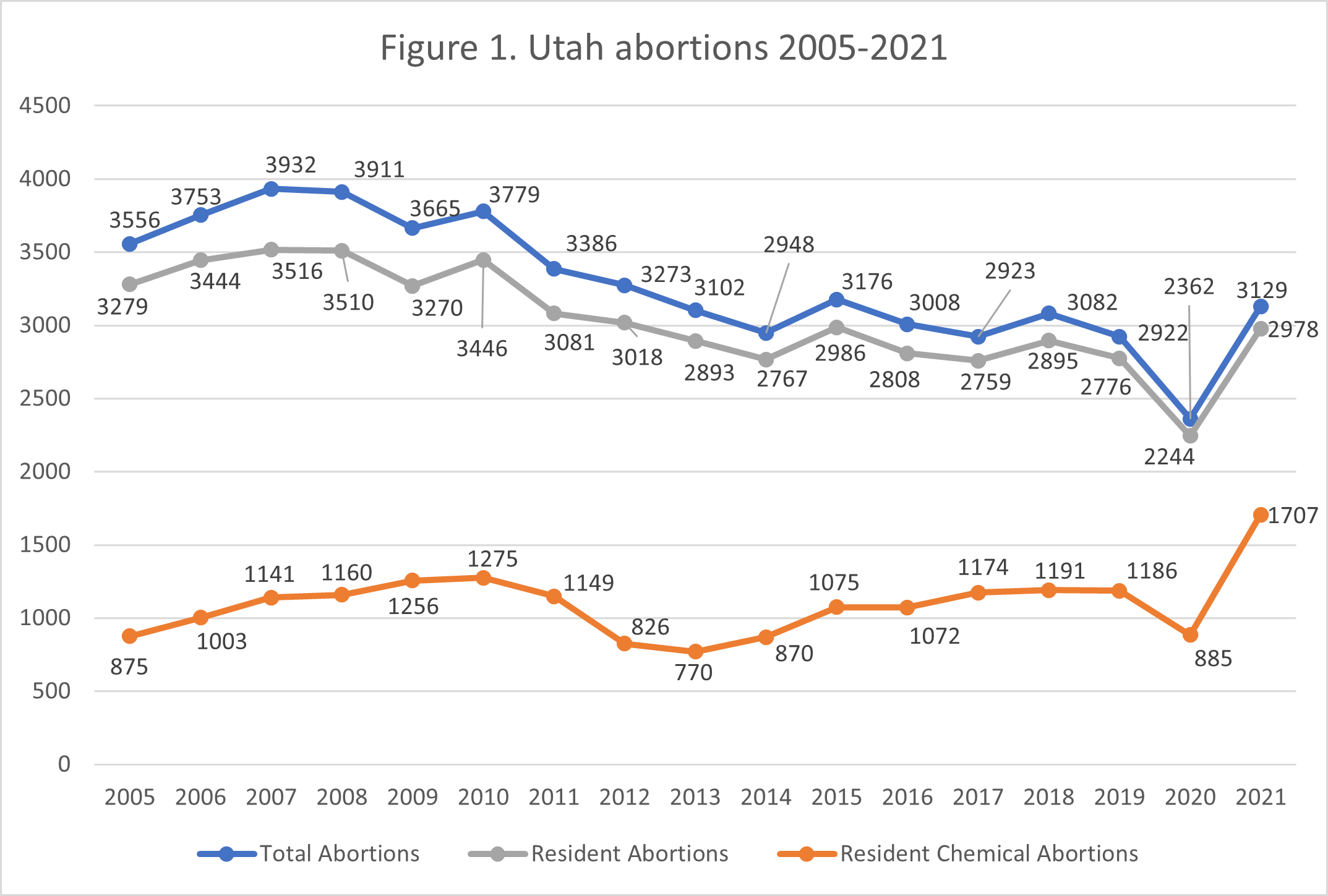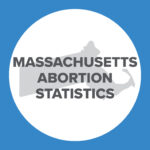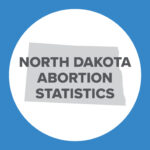Abortion Reporting: Utah (2021)
Utah’s 2021 abortion report was published online by the Utah Department of Health & Human Services in July 2023, showing that abortions increased significantly in 2021.
Statistics and Changes in Utah Abortions, 2020-2021

The change in total abortions and chemical abortions reflects abortions performed on Utah residents, while the change in the abortion rate reflects all abortions occurring in the state. The report does not include information on Planned Parenthood’s Utah abortion market share.
Abortion Totals and Trends
Utah reported 3,129 abortions in 2021, up 32% from the previous year. Of these, 2,978 were performed on residents, an increase of 33% from 2020 (Fig. 1). There were 1,707 chemical abortions performed on Utah residents in 2021, a disturbing increase of 93% from 2020. The Charlotte Lozier Institute (CLI) estimates that Utah’s 2021 abortion rate was 4.2 abortions per 1,000 women ages 15-44 (Fig. 2).1 As of October 2023, 39 states have released 2021 abortion statistics with 27 showing an increase in abortions.
State Report Summary
In 2021, 95% of the abortions reported in Utah were performed on state residents, very similar to the percentage in 2020. Five percent were performed on women from other states, including 63 on women from Idaho, 37 from Wyoming, 17 from Nevada, seven from Texas and Arizona, and 20 from other states including California, Colorado, Florida, Iowa, New York, North Carolina, Ohio, Washington, and Wisconsin. Most of the information in Utah’s abortion report is for abortions performed on Utah residents only.
Thirteen percent of Utah resident abortions were performed on girls under the age of 20. This includes 3% on minors under the age of 18 and 10% on 18- and 19-year-olds. Thirty-four percent of Utah resident abortions were obtained by women ages 20 to 24. Twenty-five percent of the abortions were performed on women ages 25 to 29, and 24% were on women ages 30 to 39. Three percent of the abortions were performed on women ages 40 and older. One abortion was performed on a woman of unknown age.
Fifty-three percent of Utah resident abortions were performed on non-Hispanic white women, and 4% on non-Hispanic black women. Six percent of the abortions performed on Utah residents were obtained by Asian or Pacific Islander women, while 1% were performed on Native American women and 2%on women whose race was not reported or unknown. Thirty-three percent of the abortions were on Hispanic women. CLI estimates that the non-Hispanic black abortion rate of 15.4 was five times the non-Hispanic white abortion rate in 2021.
Forty-two percent of the abortions performed on Utah women were on women who had graduated from high school or earned a GED, and 38% were on women with more than a high school education. Nine percent of Utah abortions were performed on women who had not finished high school, and 11% were on women whose level of education was not reported. Seventy-four percent of the abortions were performed on unmarried women, and 25% were performed on married women, including women who were separated from their spouses. Marital status was not reported for 1% of the abortions.
Just over half (52%) of Utah abortions were performed on women with no previous live births. Nineteen percent were on women with one live birth, and 28% were obtained by women with two or more prior births. Seventy-four percent of the abortions were performed on women who had reported no prior abortions, while 19% were on women with one prior abortion and 6% on women with more than one previous abortion. The number of previous abortions was not reported for 1% of Utah resident abortions in 2021.
Half of the abortions were performed on women who said they were using contraception when they became pregnant, and just under half (49%) were on women who were not using contraception. Contraception history was not reported for 45 abortions. Of the women using contraception, 7% reported using a highly effective method (which Utah lists as an implant or IUD).
Forty-two percent of Utah resident abortions in 2021 were surgical, a sharp decrease from 2020. Fifty-seven percent were chemical abortions, a dramatic increase from 2020. There were seven intrauterine instillation abortions. Seven abortions were reported to have resulted in complications at the time the abortion reporting form was filled out.2 No complications were reported for 99.8% of the abortions.
One percent of Utah abortions were performed earlier than five weeks of gestation. Forty-four percent were performed between five and six weeks, and 28% were reported between seven and eight weeks of gestation. Twelve percent occurred between nine and 10 weeks, and seven percent were reported between 11 and 12 weeks. Three percent were reported between 13 and 14 weeks of gestation. Almost 6% of Utah resident abortions were performed at 15 weeks of gestation or later, with slightly more than 4% performed between 15 and 20 weeks and 1.3% at 21 weeks or later.
Utah asks women to share their reasons for choosing abortion. In 2021, 49% of the abortions were performed for socioeconomic reasons, and 31% were elective with no other reason given. Fifteen percent of the women reported seeking abortion due to contraceptive failure, while 11 abortions were performed citing the mother’s mental health. Thirteen women cited fetal anomalies as the reason for getting an abortion while 12 women cited rape as the reason. The numbers of women who sought abortions for either drug/radiation exposure or because the mother’s life was endangered were suppressed because the numbers were less than five. The reason was not stated for 3% of the abortions. Overall, 99% of Utah abortions in 2021 were performed for some elective or unstated reason (socioeconomic, elective, contraceptive failure, and mental health).
September had the highest abortion total (293), while July (177) had the lowest.
Legislative Changes
As of August 2023, Utah’s trigger law remains blocked. Abortion is still legal in the state until 18 weeks of gestation (with limited exceptions thereafter). In February 2023, the Utah legislature introduced a bill (HB 467) which was signed in March 2023 by Governor Spencer Cox. This legislation would have made it illegal to perform an abortion anywhere but a hospital and stipulated that if one was performed at a clinic that the clinic would lose their license. Furthermore, even if a clinic did stop performing abortions, the state would not be renewing or issuing new licenses after the law was in effect. However, this legislation was blocked on May 2, 2023, one day before it was set to go into effect, by Utah’s third judicial district court and litigation on this matter is ongoing. According to a New York Times article, this law would have had a large impact on the abortion industry in the state as 95% of Utah abortions are reported to have been performed in clinics, and hospitals in the state typically do not perform abortions “outside of extenuating circumstances.” Utah’s annual abortion reports do not report abortions by facility. However, typically Planned Parenthood Association of Utah releases an annual report covering services from July to June of the following year, with the 2021 report indicating that Planned Parenthood centers in Utah performed 2,317 abortions between July 2020 and June 2021. Utah does not report the total number of abortions occurring in the state each month, but averaging Utah’s annual abortion totals for 2020 and 2021 suggests that Planned Parenthood performs approximately 94% of abortions in the state.
State Ranking
In 2016, CLI analyzed abortion reporting across the country, and Utah’s reporting was ranked at 6th best. Utah could improve its reports by incorporating information on all abortions occurring in the state, not just those performed on state residents. Utah could also require all healthcare providers, particularly emergency rooms and urgent care facilities, to report abortion-related complications they treat. Additionally, Utah could release reports on a faster schedule (e.g., within one year of the data on which it reports).


- Rates were calculated by CLI using the following formula: (total number of abortions performed in Utah ÷ number of resident women ages 15-44 [based on most recent population estimates]) x 1,000. Rates may differ slightly from previous CLI articles due to revised population estimates. Population estimates were obtained from CDC WONDER. Estimates for 2005-2009 are intercensal estimates of the July 1 resident population. Estimates for 2010-2019 are Vintage 2020 postcensal estimates of the July 1 resident population. Estimates for 2020-2022 are single-race Vintage 2022 postcensal estimates of the July 1 resident population. Estimates were produced by the U.S. Census Bureau and the National Center for Health Statistics.
- Statistics on abortion complications reported here represent a minimal number of deaths and complications, as this data is collected in a non-systematic and non-verifiable way. As such, this data cannot be used to calculate either an accurate abortion mortality rate or an accurate abortion complication rate for the state.




























